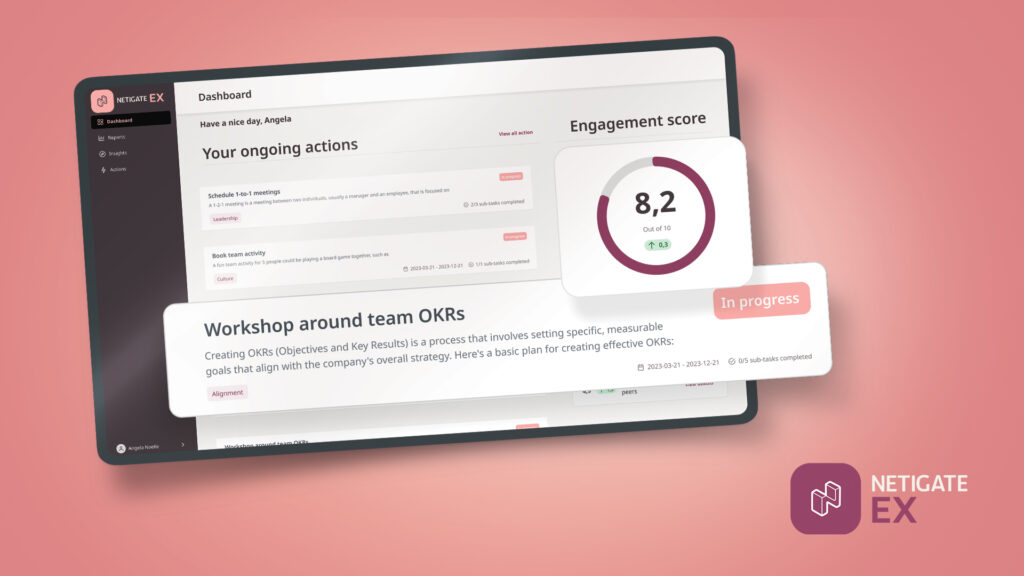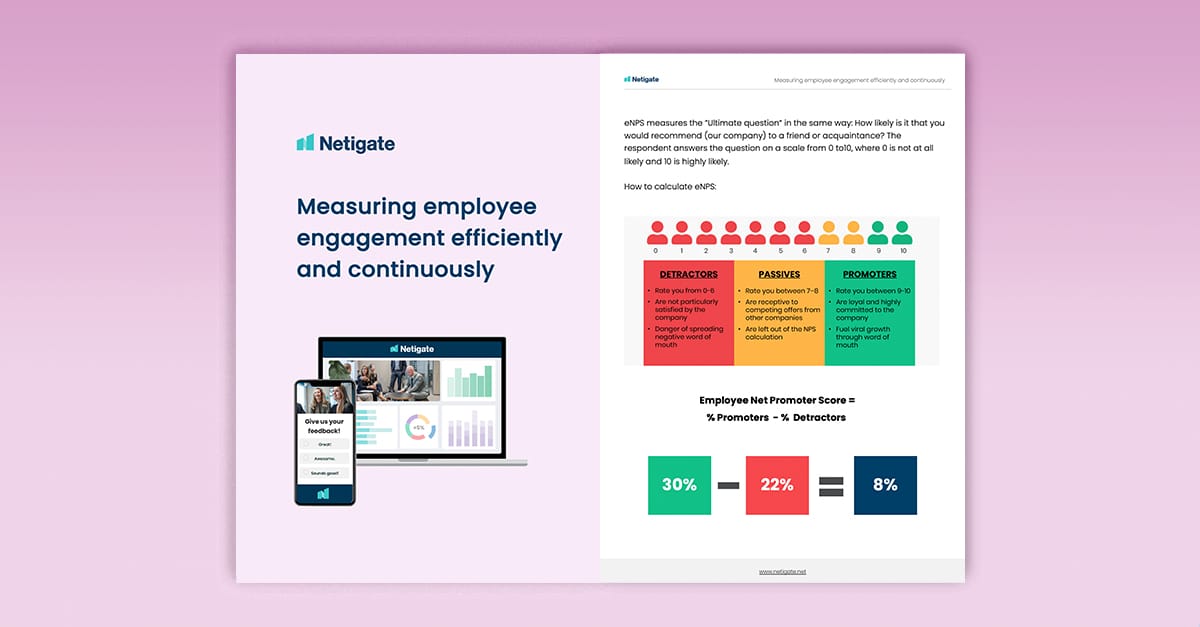In this article
Customer experience has been on the forefront of company’s strategies to improve performance for a long time. Many businesses are actively finding out what their customers are thinking with regular online surveys. But more and more companies are now recognising the importance of Employee Experience as well.
Employee experience, or EX, is an inclusive concept describing an employee’s entire workplace experience. From the first contact with a prospective employer to the last day at work, and even beyond. It lies at the interface of the two perspectives. The employee’s everyday experience at work. As well as the conceptualised experience the employer intends and designs for the employee.
In an ideal case, the two overlap.
Your organisation’s employee experience is therefore not something to take for granted. Instead, EX should be actively designed and supported through HR and management strategies and practices. Which will increase your employees’ satisfaction, motivation, performance and output.
This article shares our empirical insights from Netigate’s experience with employee experience evaluation. Together with offering tips and tricks on building out your own EX.
Why is Employee Experience so relevant right now?
Employee experience has become especially important due to a shift in the character and definition of work, combined with increased transparency and judgement of internal company practices by the public and the potential customer base.
While work in the pre-information age was manual and standardised, in the information age workplace. The individual employee and their personal set of skills have become central to the performance of good work.
We have moved away from the conviction that fulfilling an organisation’s business goals and mission is only dependent on the management and now realise the importance of the individual employee.
Greater mobility and access to education have also led to greater job choice for employees. Many companies struggle to find and employ talent, so an excellent employee experience can make a big difference when competing for hires.
If you have managed to successfully recruit a talented worker, you want to keep them.
One way is to demonstrate that your organisation is a great place to work. Employee satisfaction has become part of a company’s public image. Through digital platforms such as Glassdoor, where employees give open to feedback on their employer and workplace, everyone can easily find out how it is to work for you.
Positive employee experience and good company ethics contribute to a positive public image and brand building. It attracts future employees and customers alike!
The far-reaching impact of Employee Experience
Besides this current relevance of a positive EX, its importance is demonstrated by the impact it was shown to have on employee engagement, performance, retention and thus on the overall performance of your company and its financial return.
Research has shown that there is a direct causal link between employee experience and employee engagement. The better the experience, the more engaged the employees. This means that they are more likely to be highly motivated. Coupled with more likely to put in extra work and effort.
EX is, therefore, the first step in the causal chain towards increased company performance, because positive experience and increased engagement in turn positively affect the employee performance.
Keen to try a dedicated employee engagement platform? Try Netigate EX.
A good EX leads to higher individual performance because as employees feel more appreciated and aligned with the company, their motivation to give their best and their understanding of what is expected of them rises. On the other hand, neglecting the experience of your employees could lead to an overall drop in performance.
Moreover, a positive EX counteracts a high turnover. Surveys have shown that employees who report a positive employee experience are much more likely to stay with their employer. A good EX, besides making an employee feel at ease in the workplace, leads to them taking pride in working for the company, and so strengthens their intent to stay in the job long-term.

Furthermore, recent research has proved that a positive EX also has an impact on the financial output of your company. The IBM Smart Workforce Institute has shown how organisations who score high in terms of EX report nearly three times the return on assets and double the return on sales compared to low-scoring organisations. [1]
These findings demonstrate the broad and far-reaching impact of positive employee experience on your company’s success and shows how organisations need to acutely address EX.
EX should not stand back behind customer experience. The way of the future is to treat your employees like customers.
Off to a good start – Employee Experience in recruitment and onboarding
Employee Experience is a holistic concept that requires behavioural change and collaboration between different departments and individuals. It needs to take into consideration all stages of an employee’s time with the organisation.
Even in the recruitment process, you can establish important prerequisites for later positive employee experience. Find employees who fit into your work environment. Pre-employment testing, reference checking, peer interviews and behaviour-based interview questions can all help to identify candidates who match the company’s philosophy and ethics and will complement the team well.
Communicate behavioural standards early on to increase the chances of a behavioural change in the company.
The onboarding process, too, is crucial. It determines the expectations of the new employee regarding their future in the company. Setting the right expectations counteracts the possibility of disappointment and conflict early on and eases the employee into the new environment. Make their first few days in the company memorable – first impressions do count! Do not be afraid to ask for feedback early on through an employee experience platform.
In the way you divide customer target groups into different segments, remember that your employees likewise are a diverse crowd. Be aware of generational differences and understand what motivates your different employee groups and how you can improve their experience and help them reach their potential.
What motivates a millennial might not work for an employee from Generation X.
Design employee surveys accordingly to find out who your employees are and where they want to go with the company. By personalising the employee experience, you can improve overall satisfaction and motivation levels. With the help of smaller pulse surveys, you can always do check-ins on development and change, as well as operational processes.
Invest in your employees – Training and Personal Development
Another important aspect of positive employee experience is personal development. By creating a plan for consistent and continuous training and providing a learning platform, you demonstrate your commitment to the value of developing your employees and so gain their trust.
Depending on your organisation and its scale, you may want to focus on training leaders to pass on knowledge and skills to their team members. For larger organisations, consider digital and cognitive innovations as presented below to address the individual employee.
To find out where an individual employee needs improvement or to identify strengths you want to build on, conduct a 360-degree feedback survey and include a self-evaluation part. You can include this, and all other steps, into a comprehensive employee experience management system that works for your company.
The importance of good leadership practice
Be aware that good workplace practice begins with your company leadership. They need to build a trusted relationship with their employees. This can be achieved through communication and transparency.
The practice of rounding is particularly successful in this regard: Walking around the office where possible, talking to employees, inquiring about successes and problems, showing presence, and communicating and discussing developments in the company that affect the employees all creates a positive employee experience. They are made to feel part of the larger endeavour of the company, develop trust in their team leader, and learn to articulate their complaints.
Another soft skill for leaders is to make their employees feel appreciated and to keep a healthy ratio of complementing and criticising. When it becomes necessary to criticise employee behaviour, take the coaching approach and correct the behaviour while stressing your support, and then later follow up. Give feedback and recognise good performance.
Giving feedback and showing appreciation
In order to improve the employee experience, we recommend giving (and receiving) frequent feedback through an employee experience platform. Not just for the annual performance evaluation. Employees want to feel that their work is meaningful and that they are heard and valued.
Recognising good performance and including feedback from customers and beneficiaries of their work can increase this sense of working successfully towards a goal. Use 360-degree feedback to incorporate the rest of the team in the process. Learning how their peers think about their performance and contribution can increase the sense of being appreciated and fuel the will to improve.
In addition to that, lead frequent personal performance conversations in a more informal manner if possible. Employees want to feel that they belong and are part of the team and organisation. Strengthen social connections in the team by providing spaces to socialise, meet in the office, and exchange ideas. Positive and supportive co-worker relationships add to an outstanding EX.
The key of ‘Co-’: Employees designing their experience
Don’t let the HR experts tackle improving EX in isolation. Engage your employees in the design process of your employee experience strategy and base it on data and research. Find out what your employees think and avoid the pitfall of designing an experience that no one actually wants.
One approach is to institutionalise this participation in the form of an Employee Experience Team formed by volunteer employees and headed by an HR professional.
Participation in change makes it easier to ease into it. Moreover, pride in new co-developed concepts and strategies facilitates an easier implementation and increases justification for changes.
Again, build on the strength of having a diverse and multi-generational employee group and make up the team accordingly. Every segment should be represented. But remember that every person can also change throughout their employee journey – so remember to keep checking in!
Listen to your employees – and have them take a survey!
Employee feedback surveys can be hugely beneficial. The key to improving your employee experience is by continuously listening. On a smaller scale, this can be partly done by rounding and personal feedback, but on larger scales employee surveys and reviews become vital. We at Netigate have helped more than 2,000 organisations and companies worldwide, from small startups to big Fortune 500 companies, to conduct insightful employee surveys with the right employee experience management tools that yield actionable feedback.
Our top tips for designing productive employee surveys are:
- The surveys should be explicitly confidential, anonymous, and actively supported by the management
- You should conduct surveys on a regular basis to track developments
- Keep them short and concise to motivate everyone to participate and give detailed feedback
- Collect demographic information to interpret generational/gender/minority/etc. differences
- Ask questions that require constructive feedback that employees can act on
Depending on your interests and needs, you can implement different kinds of employee surveys:
- Employee Engagement Surveys using eNPS (Employee Net Promoter Score) enable you to measure your staff’s overall attitude and loyalty towards you as an employer. Together with how likely they are to recommend you with short and simple questions. It is a quick and easy way to get direct conclusive feedback on your employees’ level of engagement.
- Employee Satisfaction/Experience Surveys are longer and more inclusive surveys on the physical and human workspace, satisfaction with work, achievements, and communications with leaders and training opportunities. They give you insight on which areas of employee experience need improvement.
- Employee Onboarding Surveys give you feedback on how successfully the onboarding process was organised, staged and helped the new employee start off in your organisation.
- 360-Degree Feedback Surveys are an effective way to create self-awareness of strengths and weaknesses in your employees, spark personal development, and increase overall company performance. In terms of employee experience, they can be used to help leaders improve their communication skills. This in order to increase employee trust and comfort in the work environment.
Remember to follow up on changes you have done after the initial survey with a review survey to see which strategies were successful. What has improved in the experience of your employees, and what still needs further development. Listening to your employees and making enhancements to their experience is an ongoing and continuous process.




